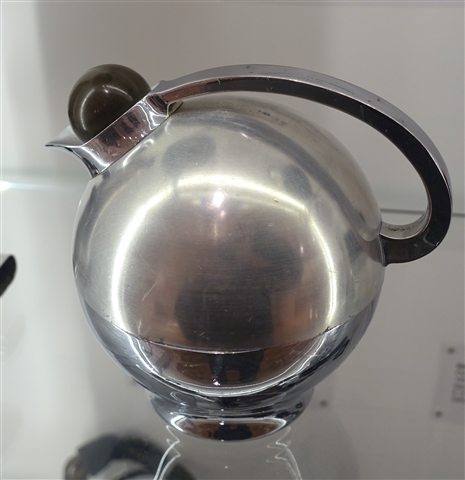On this day in (engineering) history…
November 5, 1893 – Birth of Raymond Loewy, Industrial Designer
Question: What do the Greyhound bus, Air Force One livery, the Fanta bottle, the Studebaker Avanti car, the Shell Oil company logo, the Sunbeam Toaster, the Pennsylvania Railroad GG1 locomotive and the Skylab space station interior all have in common?
Answer: Raymond Loewy.
Raymond Loewy was one of the biggest names in what became known as mid-century modern industrial design, with an influence still felt in modern design's clean, functional lines.
The blank paper
‘The Man Who Shaped America’ was born in Paris, today in 1893. His parents were Maximilian Loewy, an Austrian Jewish business journalist, and Marie Labalme, a go-getter whose personal mantra was ‘it is better to be envied than pitied.’ He studied electrical engineering at the University of Paris, picking up his degree in 1910, and moving on to study advanced engineering at the Ecole Duvignau de Lanneau, also in Paris.
Back in 1908, before he completed his electrical engineering degree, Raymond discovered a talent for designing and flying model airplanes, winning the Gordon Bennett Cup for model planes in that year.
The outbreak of war in 1914 put an end to any plans he may have had. Raymond signed up for the French Army, beginning as a private soldier, rising to become a captain and winning the Croix de Guerre for bravery.
Raymond Loewy designed Airforce One livery, 1962. Requested by Pres. John F. Kennedy, at the suggestion of Jackie Kennedy. Source: Wikimedia Commons
Deciding on a subject
After the war, in 1919, Raymond left the land of his birth, for the USA, even so, he maintained a connection with France for the rest of his life.
His lucky streak began en route to America - he entered a sketch into a ship-board talent competition. This caught the eye of the British consul in New York, Sir Henry Armstrong, who gave him a letter of recommendation to any future employers. In a year, Raymond had made himself an in-demand fashion illustrator at Vogue magazine, for catalogues and advertising, while designing window front displays for department stores - such as Macy’s and Saks Fifth Avenue – at the time, the main methods for engaging customer desires.
Frustration set in by the end of the 1920s. He turned his attention from illustrations, to designing products themselves, not least because of what he felt was the poor design of too many US products.
It was here Raymond found his calling.
Preparatory sketches
Sigmund Gestetner was a British manufacturer of mimeograph machines, who felt his products needed refreshing. Raymond’s first task as a nascent industrial designer was to do just this.
Over three days, Raymond stripped down the casing to the bare minimum of shape and functionality, in effect ‘streamlining’ the machine’s appearance. Gestetner’s duplicating machines used the Loewy shape for the next forty years, until other forms of duplication, such as early photocopying, overtook mimeography.
This assignment established industrial design as a concept in the United States, so much so that Raymond opened his first design studio, ‘Raymond Loewy Associates’ in 1930.
Good, aesthetically appealing design did not simply make the product look better; it produced results in the sales figures. The next major project, the Coldspot refrigerator of 1934 for Sears and Roebuck, is a good demonstration of this. Streamlined along the same lines as the Gestetner duplicator, it, too, became a hit.
The new look, along with rust-proof aluminium (or aluminum) shelves, took the appliance from sales of 60,000 to 275,000 in two years.
Raymond took on car design in the late 1930s, convinced there was unmet demand for a lightweight, slimline compact car. His designs featured elegant, streamlined shapes that looked far ahead of their time.

Pennsylvania Railroad's S1 locomotive "Pennsylvania," of 1939 - with its all-welded exterior. Source: Wikimedia Commons
Motion blur
The Studebaker Champion (1938) and President (1939) - described as ‘the best-looking car of the year’ - were both successful vehicles. His 1953 Studebaker Starliner persuaded the press that there ‘is a market for a personal luxury car.’
Studebaker was selling 300,000 cars in 1950, the pinnacle of its success. In the early 1960s, when the company needed a hit to revive its fortunes – Studebaker turned to Raymond and his team. The result was the Studebaker Avanti from 1962, a strikingly distinctive all-fibreglass car that set speed records on Bonneville Salt Flats in Utah for a consumer production car.
The streamlining did not stop with railway locomotives and cars, but extended to busses, when he designed the exterior and interior of Greyhound Lines, beginning with a design for the ‘Scenicruiser,’ in 1935. By the mid-1950s, Raymond had given Greyhound a new logo...unbelievably, a true greyhound. He had changed the interior, by now the bus seats used materials with designs that made marks and spots look natural and innocuous. Finally, he gave the buses themselves his characteristic sleek, streamlined look.
Everything, everywhere, all at once
By 1949, Raymond ran the world’s largest industrial design consultancy, his success and influence were both undeniable and everywhere, he had (literally) given shape to an era.

Thermos flask, Model 3750, designed by Raymond Loewy, 1937 Source: Wikimedia Commons
Aside from cars, locomotives and refrigerators, Raymond and his team designed vacuum cleaners, toasters, shavers, tractors, ballpoint pens, electric fans and kitchen ceramics. Inevitably, Raymond’s career went beyond product design. He designed interiors for restaurants, cafes, department stores, buses, airliners, and NASA.
In 1967, Raymond was hired as a consultant by NASA to design the interior of capsules for the moon missions and for the Skylab space station. With the space station, he attempted to create an environment that simulated gravity, creating spaces with different identities for the crew to either work or relax in. Plus, a porthole to provide a view of the Earth.
Besides designing the products and the interiors, he developed corporate logos and colour schemes, many of which are still in use, such as the Airforce One livery, the US Coastguard Racing Stripe livery, the Exxon and Shell Oil's logos and the iconic Lucky Strike cigarette pack.
Finished product
With Raymond Loewy, many things converged at the same time. The rapid development of technology and the post-war surge in economic prosperity were followed by the post-war explosion of consumer products, a means of selling them and a mass media to promote them. None of it, however, would have been possible without Raymond’s ability to unite different disciplines across so many areas of activity. And it all started with his engineering education in Paris.
It all ends in France, too. In 1970, Raymond’s New York office mostly worked on store interiors, which did not really interest him, so he sold the office and moved his activity to Friborg, Switzerland. Most of his business was in Europe by the end of the 1970s, a region he described as being where the US was 25 years earlier in its use of design.
He retired in 1980 and returned to Paris, where he had long kept a home. Raymond died in Monte Carlo on July 14, 1986, aged 92.
It is worth quoting a response to Raymond’s life in the New York Times: Susan Heller wrote, “One can hardly open a beer or a soft drink, fix breakfast, board a plane, buy gas, mail a letter or shop for an appliance without encountering a Loewy creation.” Allowing for technological change is nearly as true now as it was then.
-----------------------------------------------------------------------------
What do you think?
Designers are often unsung when it comes to the products we use every day. Who else do you think has a similar impact as Raymond Loewy?
-----------------------------------------------------------------------------
 By Stephen Phillips - IET Content Producer, with passions for history, engineering, tech and the sciences.
By Stephen Phillips - IET Content Producer, with passions for history, engineering, tech and the sciences.
